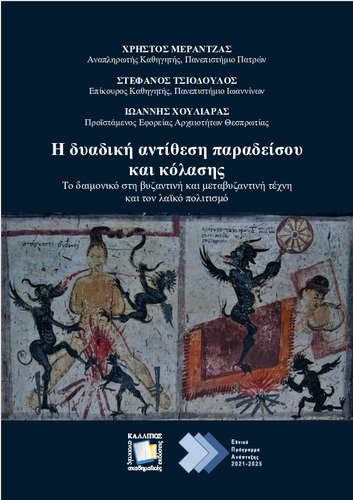| Title Details: | |
|
The Binary Opposition of Heaven and Hell |
|
| Other Titles: |
The Demonic in Byzantine and Post-Byzantine Art and in Greek Popular Culture |
| Authors: |
Merantzas, Christos Tsiodoulos, Stephanos Chouliaras, Ioannis |
| Subject: | LAW AND SOCIAL SCIENCES > ANTHROPOLOGY (NON PHYSICAL) > SOCIAL AND CULTURAL ANTHROPOLOGY LAW AND SOCIAL SCIENCES > ANTHROPOLOGY (NON PHYSICAL) > SOCIAL AND CULTURAL ANTHROPOLOGY > CULTURE AND LIFESTYLE > CULTURAL HERITAGE HUMANITIES AND ARTS > HISTORY > GENERAL HISTORY, THEORY > BYZANTINE HISTORY HUMANITIES AND ARTS > HISTORY > SPECIALIZED HISTORIES > CULTURAL HISTORY HUMANITIES AND ARTS > HISTORY > ARCHAEOLOGY > BYZANTINE ARCHAEOLOGY HUMANITIES AND ARTS > HISTORY > ARCHAEOLOGY > POST-BYZANTINE ARCHAEOLOGY HUMANITIES AND ARTS > ARTS AND LETTERS > ARTS > NATIONAL ART > EUROPEAN ART > BYZANTINE ART HUMANITIES AND ARTS > PHILOSOPHY > APPROACHES AND SCHOOLS IN PHILOSOPHY > GENDER THEORIES |
| Keywords: |
Binary oppositions
Christian salvation Paradise Hell Demon Saint Andrew the Fool Saint Basil the Younger Post - byzantine art Byzantine art Otherness Hades Sexual abstinence Sexual practices Eroticism Genitals Gender identities Tools of torture Sexuality |
| Description: | |
| Abstract: |
Based on primary Byzantine sources and on an extremely large number of unpublished material with scenes of the Last Judgment, from Byzantine and post-Byzantine tradition, but also on oral testimonies of Greek popular culture, we examine the form of biopower constructed by the image of hell, where the fallen from paradise. It is no coincidence that in the scenes of torture the bodies in hell are sometimes represented by their secretions and therefore they become infectious bodies. In this context the nature of hell is referred as heterotοpic that delimits the environment of otherness which is characterized from uncertainty and runs the risk of deflowerment Hell is the place of the demonic, which represents the discharge of the thymic, the animality of reproduction and unrhythmic sexuality, the monstrous and inhuman nature, evident in the fantasy representation of the black-faced and winged monster with hybrid features, familiar in popular culture. The latter expresses the entanglement of sexuality and genetic abnormality which is anything but distanced from animal primogeniture. On the other hand, the salvation of heaven is indicated, in contrast to the destruction of hell, by the construction of a familiar and an alien body, an able-bodied body and a body that has lost its integrity and is miasmatic, to which are emphatically subscribed the co-demonstrations of rape practices (loss of purity). Consequently, the environment of hell, in contrast to that of heaven, makes clear the distinction between embodied and disembodied states, while heaven, for the sake of celibacy, is placed outside the narrow limits of demographic (reproductive) anguish.
|
| Linguistic Editors: |
Krokidi, Sofia |
| Graphic Editors: |
Kalogera, Maria P. |
| Type: |
Undergraduate textbook |
| Creation Date: | 14-03-2023 |
| Item Details: | |
| ISBN |
978-618-5726-63-8 |
| License: |
Attribution - NonCommercial - ShareAlike 4.0 International (CC BY-NC-SA 4.0) |
| DOI | http://dx.doi.org/10.57713/kallipos-181 |
| Handle | http://hdl.handle.net/11419/9212 |
| Bibliographic Reference: | Merantzas, C., Tsiodoulos, S., & Chouliaras, I. (2023). The Binary Opposition of Heaven and Hell [Undergraduate textbook]. Kallipos, Open Academic Editions. https://dx.doi.org/10.57713/kallipos-181 |
| Language: |
Greek |
| Consists of: |
1. The iconography of punishments in Byzantine and early post-Byzantine wall painting 2. The iconography of punishments during the 13th and 14th centuries in churches of Greece and Cyprus 3. The iconography of punishments during the 15th and 16th centuries in churches of Greece and Cyprus 4. The iconography of punishments in the 17th century in the Greek area 5. Dreaming visions of the Christian paradise 6. Between heaven and hell. The integral parts of a whole or the extreme poles of a binary opposition? 7. Theodora's journey through the heavenly tolls in the Life of Basil the Younger 8. The Heavenly Jerusalem and the preparations for the Last Judgement in the Life of Basil the Younger 9. Punishment and gender in Byzantine and post-Byzantine iconography of hell 10. Demonology in Greek popular culture |
| Number of pages |
337 |
| Publication Origin: |
Kallipos, Open Academic Editions |
| You can also view | |
| User comments | |
There are no published comments available! | |

